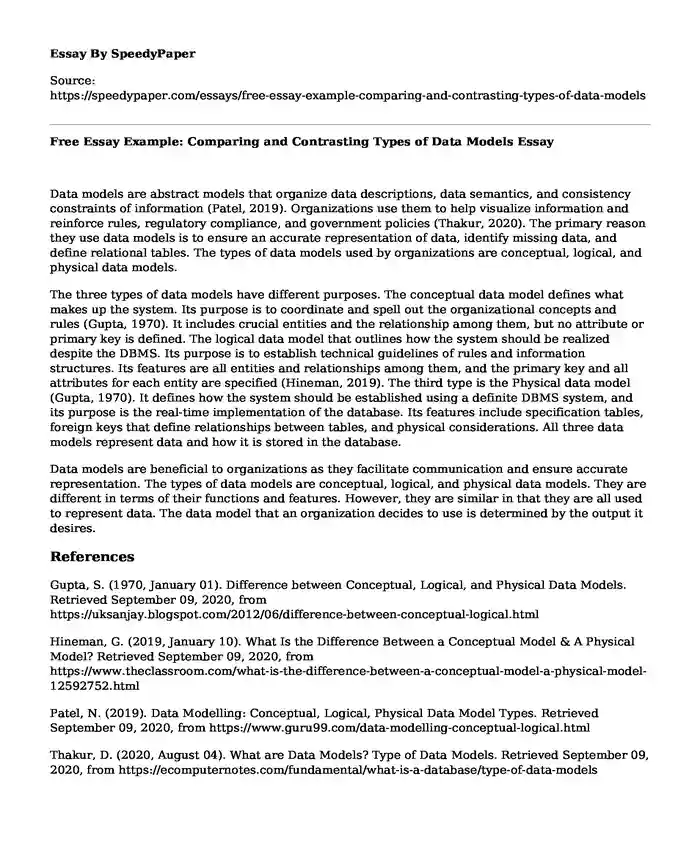
| Type of paper: | Essay |
| Categories: | Data analysis Organizational culture |
| Pages: | 2 |
| Wordcount: | 379 words |
Data models are abstract models that organize data descriptions, data semantics, and consistency constraints of information (Patel, 2019). Organizations use them to help visualize information and reinforce rules, regulatory compliance, and government policies (Thakur, 2020). The primary reason they use data models is to ensure an accurate representation of data, identify missing data, and define relational tables. The types of data models used by organizations are conceptual, logical, and physical data models.
The three types of data models have different purposes. The conceptual data model defines what makes up the system. Its purpose is to coordinate and spell out the organizational concepts and rules (Gupta, 1970). It includes crucial entities and the relationship among them, but no attribute or primary key is defined. The logical data model that outlines how the system should be realized despite the DBMS. Its purpose is to establish technical guidelines of rules and information structures. Its features are all entities and relationships among them, and the primary key and all attributes for each entity are specified (Hineman, 2019). The third type is the Physical data model (Gupta, 1970). It defines how the system should be established using a definite DBMS system, and its purpose is the real-time implementation of the database. Its features include specification tables, foreign keys that define relationships between tables, and physical considerations. All three data models represent data and how it is stored in the database.
Data models are beneficial to organizations as they facilitate communication and ensure accurate representation. The types of data models are conceptual, logical, and physical data models. They are different in terms of their functions and features. However, they are similar in that they are all used to represent data. The data model that an organization decides to use is determined by the output it desires.
References
Gupta, S. (1970, January 01). Difference between Conceptual, Logical, and Physical Data Models. Retrieved September 09, 2020, from https://uksanjay.blogspot.com/2012/06/difference-between-conceptual-logical.html
Hineman, G. (2019, January 10). What Is the Difference Between a Conceptual Model & A Physical Model? Retrieved September 09, 2020, from https://www.theclassroom.com/what-is-the-difference-between-a-conceptual-model-a-physical-model-12592752.html
Patel, N. (2019). Data Modelling: Conceptual, Logical, Physical Data Model Types. Retrieved September 09, 2020, from https://www.guru99.com/data-modelling-conceptual-logical.html
Thakur, D. (2020, August 04). What are Data Models? Type of Data Models. Retrieved September 09, 2020, from https://ecomputernotes.com/fundamental/what-is-a-database/type-of-data-models
Cite this page
Free Essay Example: Comparing and Contrasting Types of Data Models. (2023, Dec 06). Retrieved from https://speedypaper.com/essays/free-essay-example-comparing-and-contrasting-types-of-data-models
Request Removal
If you are the original author of this essay and no longer wish to have it published on the SpeedyPaper website, please click below to request its removal:
- The American Imperialism Essay Example
- Free Paper with a Speech Example: DNA Evidence
- Essay Sample Describing Weather History and Geology of Pali Hawaii
- Free Essay on Organization and Unit Mission, Vision and Values; Shared Governance
- Essay Sample on the Crisis in the Humanities
- Essay Sample on Databases for Evidence-Based Nursing Research
- Free Essay Sample on Directions - Apple Inc. Organization
Popular categories




